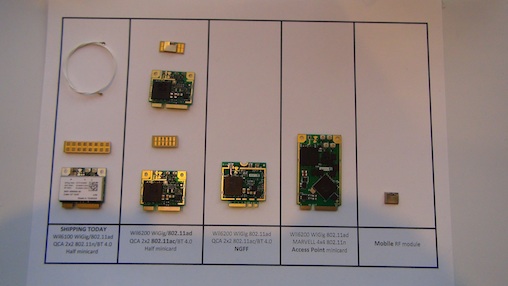Fabless semiconductor maker Wilocity and Qualcomm announced what they're calling the first multi-gigabit wireless chipset reference architecture based on the new WiGig 60GHz and IEEE 802.11ad standards for high-speed downloads,docking and networking.

Wilocity's new WiGig 60GHz chipset
Based on Qualcomm's VIVETM 802.11ac Wi-Fi and Wilocity's 802.11ad WiGigTM wireless chips,the reference design delivers tri-band Wi-Fi,which allows consumers to connect to 60GHz-enabled devices,docks,displays and storage at multi-gigabit speeds,while maintaining enterprisewide or consumer home coverage with 2.4GHz/5GHz Wi-Fi.
Wilocity also announced at International CES that Dell has become the first system manufacturer to include the wireless chipset in its new Latitude 6430u Ultrabook.

The latest generation tri-band wireless networking card uses the new Qualcomm VIVE 802.11ac combined with the recently ratified 802.11ad standard that enables multi-gigabit networking,data syncing,and video and audio streaming,while maintaining its wireless bus extension docking capabilities.
Wilocity claims its new chipset for mobile devices and peripherals can stream data such as high-definition video at distances of up to 40 meters at speeds that are more than 10 times faster than today's typical Wi-Fi transmission rates.
In one demonstration,Tal Tamir,Wilocity's CEO,showed an HD movie running on the Dell computer that was split into three streams.One ran on the Dell notebook,while two others ran on two remote 1080p monitors.The video was consistent on all three screens,showing that there was near-zero latency using the wireless feed.
Tamir then demonstrated direct-attached storage(DAS)capabilities by wirelessly transferring a file to a solid-state drive enclosed in a drive case with a PCIe interface.The SSD represented DAS on a desktop.
The wireless chipset transferred data at rates that averaged about 1.46Gbps.
"USB 3.0 would provide 36MB,that's megabytes,per second,"Tamir said."This runs faster than a RAID system.[This is the year]of WiGig,and we're proud to be at the forefront of bringing consumer and commercial products to market,along with our technology and[system manufacturer]partners."
Wilocity plans to sell its chipset to laptop system makers first,and eventually expand into the mobile device market,Tamir said.
The chipset has 32 radio antennas in order to run concurrent multi-gigabit I/O.For example,in one demonstration,Wilocity showed how they could backup files to two separate network routers on opposite walls of a hotel room.Both I/O streams hit transfer rates that exceeded 120MBps or 1Gbps.
The routers represented what could be network-attached storage in an office,according to Mark Grodzinsky,Wilocity's vice president of marketing,
Grodzinsky explained that the demos didn't achieve multi-gigabit performance due to several bottlenecks throughout the system."The wireless link is at 4.6 Gbps,the PCIe interface is at 2.5 Gbps,and then there is some overhead.If we ran multiple reads and writes simultaneously,we could get multi-gigabit[speeds],"he said.





